Construction Article and Review of "Extase" (Pronounced "Ecstacy")

OH YEAH !! Test flights were great! (06-16-02)
See the bottom of this page for an update on other flying sessions, 06-20-02 & 06-23-02.
First things first ...The Photos! (Technical stuff later)
Ready-to-fly weight, with fuel is only 6.25 lbs.! This puts the (970 square inches) wing loading at less than 15 oz./sq. ft.. On the initial flights, we used the factory-suggested CG, which worked well. "Extreme" (60 degrees or so) high rates were set up, with the low rates at 35 percent of that. We used 35 percent exponential on high rates, and none on low rates. ...Totally smooth. We flew the plane all day with the "2-6" mix on. (Elevators commanding opposite flaperon deflection) This gives the plane even better handling at low speed, and we also did roughly 10 ft. diameter loops!
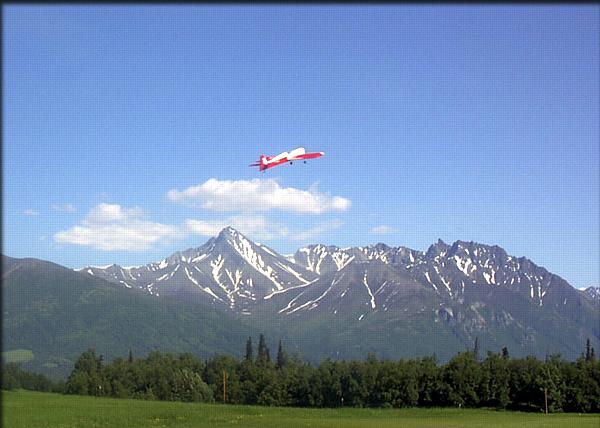
The first takeoff, into beautiful Alaskan skies, on 06-16-02
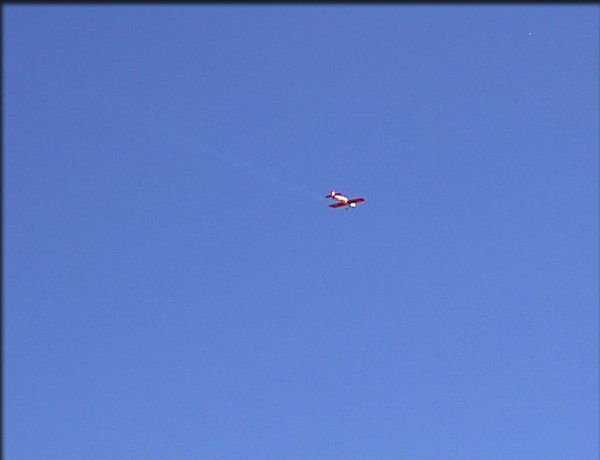
Some medium speed passes, adjusting trims... Very minor trim adjustment was needed, since I checked the CG and laterally balanced the plane before we flew it.
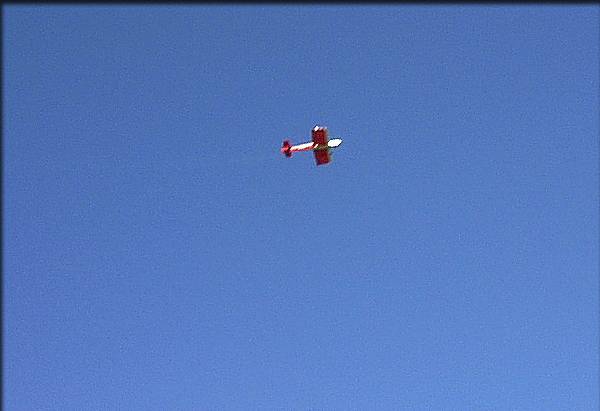
A little slow flight, at a safe altitude (New engine)
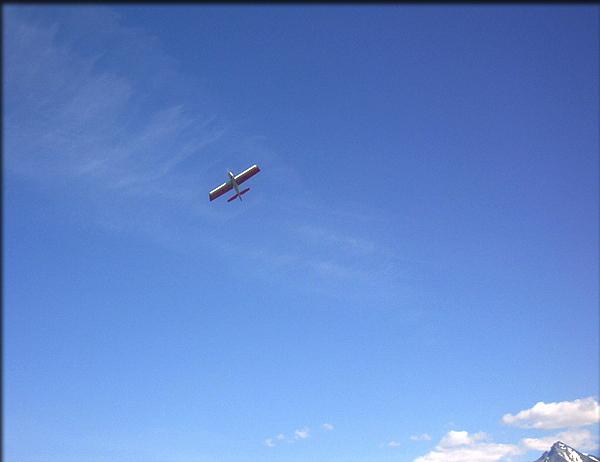
Starting to get a little "frisky", enjoying the high rates. The "2-6" (Elevator-Flap) mix gives you some truly awesome slow flight possibilities, as you'll see...
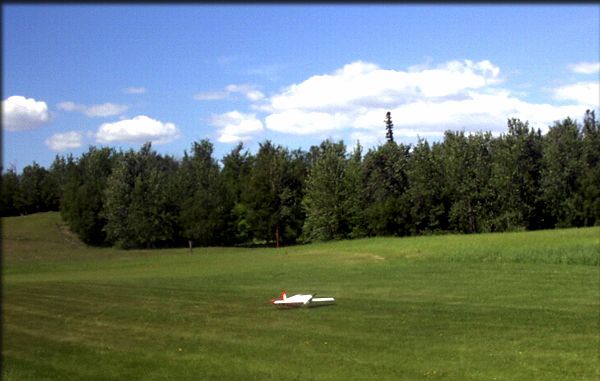
First landing (deadstick due to fuel exhaustion) was a piece of cake.
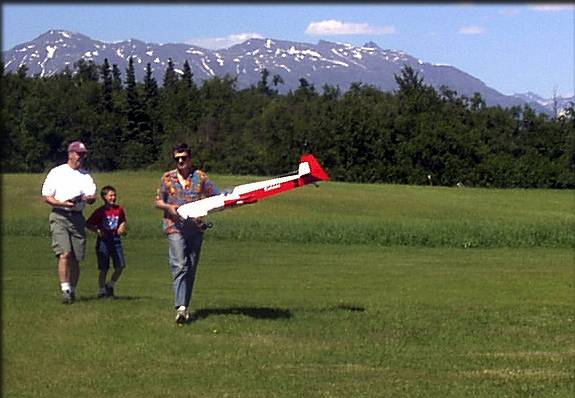
A happy and relieved pilot (me) heading for my fuel can! I flew this plane pretty much relentlessly the rest of the day, aided by my fellow RC pilot friends, who also had a ball flying it! ...Interesting how easy it is to make new friends when you show up with a plane like this... Of course, handing them the transmitter helps... a lot!
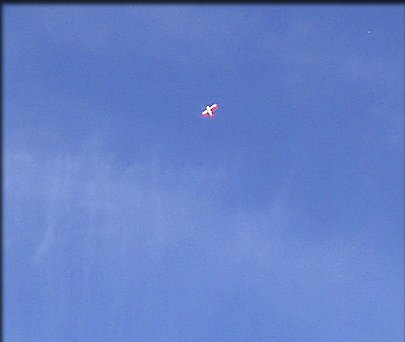
Vertical is unlimited with the YS .91 4-stroke I used. I started the day with a 14/8 prop, but later Bruce loaned me an APC 15/6. The engine peaked at 9900 RPM (higher than expected) and idled around 2000 RPM. The 15/6 prop also improved the slow flight & hovering characteristics.
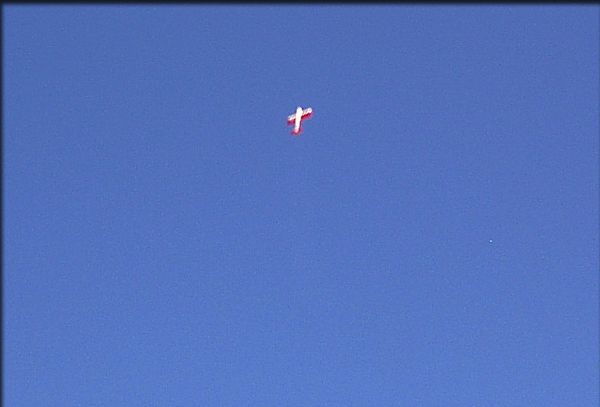
This airplane does a fine job of hovering and torque rolling!
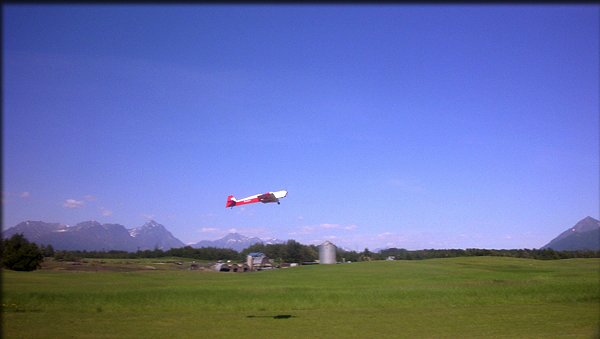
Next, we started to get low and slow...
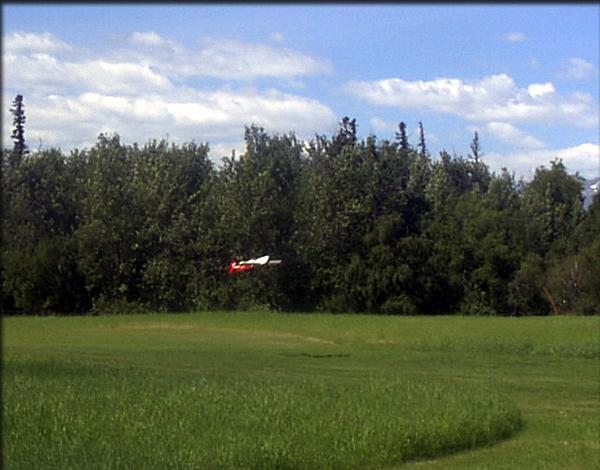
We flew the "Extase" around in this configuration a lot, and it's very stable.
With a little more experience, and a little more engine break-in
this is a plane that could easily do a harrier landing.
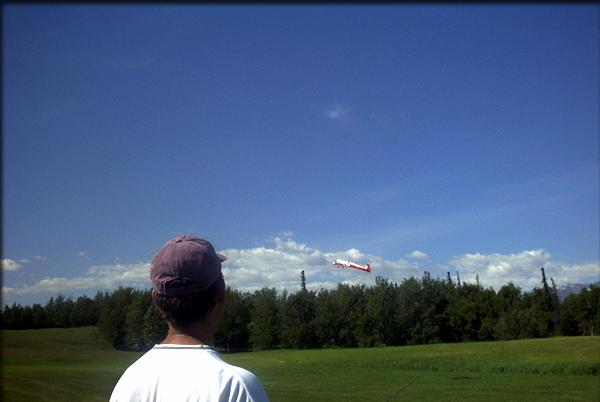
My friend and 3D pilot, Bruce Stingley, really cranking it around, very low, and very slow. This plane has no bad habits that we saw, trying all the maneuvers we could think of. We flew with the "2-6" elevator-to-flap mix on all the time, once we saw that we could do 10 foot diameter loops with it on!
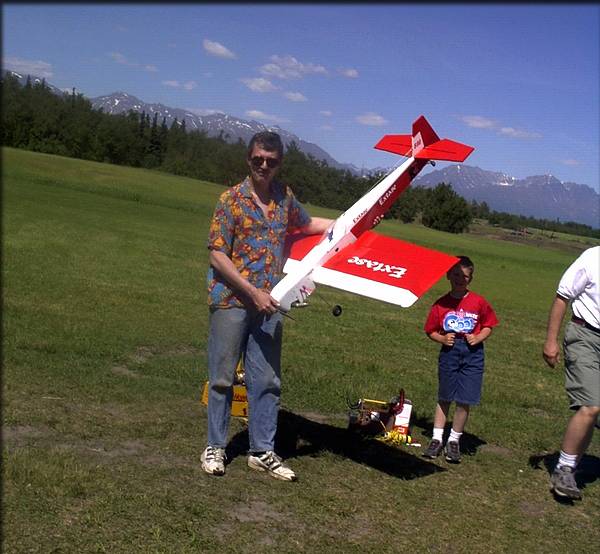
I look a little sad here...
That's because we had to go, but I wanted more fuel, instead!
Trimming & Flying
As I mentioned, we began flying the plane using the factory recommendation for the CG, which is located 150mm (5.9 inches) from the wing's leading edge. Because I was using a YS .91 4-stroke, this required the addition of 2 oz. of lead to the tail. ...no bigee. This CG position seems fine, and only time with the plane will show whether it needs to be adjusted or not.
The plane balanced laterally out of the box. ...Nice. High rates were only used for hovering and extreme maneuvers. Likewise, full throttle was only used for vertical maneuvers, and we spent most of the flight time at less than 1/2 throttle. Since this was a new airplane and a new engine, we flew it a bit on the conservative side. That is, we did all the maneuvers, but we did them at a relatively high altitude. The airplane showed no bad habits, and no tendency to snap, even at very low speed. Both the ground handling and the landings are very easy. I really have no complaints at all, and everyone who saw and flew the plane thought it was great.
One particular thing that several of us like about flying the plane is it's long tail moment. This makes all the maneuvers, including the extreme ones, very smooth. ...not "twitchy" or "scary" at all. In knife edge flight, the airplane wants to roll and pitch toward the canopy. The condition isn't severe or dangerous, just a quirk. Maybe later, we'll find that adjusting the CG will help. It's also possible that the pitch "up" may translate to something helpful when flying low and slow. After all, one day of flying the plane isn't enough to really get used to it. I had BIG FUN flying it!
One final note you may like hearing. I used a Futaba T6XA radio, with standard Futaba S3003 servos, a standard 4-cell battery pack, (with the "standard" big Futaba servo wheels) and had no problems with control authority at all. You don't need a whole new set of fancy servos (It uses 5) to fly this plane. I did use some ball-link hardware for the connectors, just to be safe in avoiding slop and vibration problems, but nothing "exotic". I think this plane is a winner!
The second flying session, on 06-20-02 was even better!
We sneaked out on a Thursday and went flying again. This time, it was my plan to get some tips from the local "3D Masters", on things such as adjustment of the engine thrust offset, control throws, and general performance. Several of them flew it, and all of them said, "Don't change a thing." (It was suggested that I install some faster, more expensive servos and control arms, and I agree. I wanted to review the kit with all "standard" equipment first though.)
Now that the "first flight" nerves are gone, and the engine is broken in, I've started to have even more fun with this airplane. It's a blast to fly along incredibly slow, then just "blip" the throttle and yank it around. With the elevator-to-flap mix on, this airplane will "loop", both inside and outside, in it's own length, like a small "Fun-Fly" type. In a stall turn, blipping the throttle will produce the same response in yaw... The plane turns immediately. yet it's still got the smoothness associated with it's long tail, and is really a pleasure to fly. Now if I can just learn to hover smoothly...
The third flying session, on 06-23-02 was short, but sweet.
Although our day was cut short by rain, I spent my time with the "Extase" flying extremely slowly, just on the verge of a stall. The stall in this mode is very obvious, preceeded by wing rocking, so there's no reason to ever be surprised by it. I also began practicing sideslipping the plane to see how it handles in that mode. My sideslips were a bit sloppy at this point, but I found that the plane can be brought down quite quickly if needed. Hopefully, next weekend I'll have more time to get comfortable in those modes, and find out what else the "Extase" can do.
The fourth flying session on 06-30-02...
Yep, this weekend was beautiful, and I got in at least 5 flights with the "Extase". I simply am having a ball with this plane. It can fly sooooo slow, if you like, and is almost impossible to stall. Several times, on landing, while holding up elevator, the plane almost lifted off again, while practically at a standstill. All the local 3D "pros" can hover the plane as soon as I hand them the transmitter. For me, a hover of about 5 seconds seems to be my current limit, but I'm relatively new to 3D. That gives me a good excuse to fly the plane till I get it right!
You can contact RC Plane Power by calling (401) 231-5380, or by writing them at:
RC Plane Power
2193 Mineral Spring Avenue North
Providence, RI. 02911
>>> Mike James
Kit Overview | Construction | Trimming & Flying